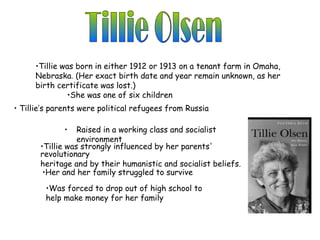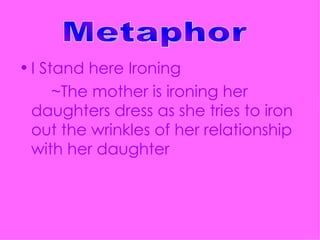Tille olsen 2
- 1. By, Julia Boitano, Alexa Profit, Casey Quinn, Kerry Haggerty, Sarah Peters, and Jackie McCormack
- 2. •Tillie was born in either 1912 or 1913 on a tenant farm in Omaha, Nebraska. (Her exact birth date and year remain unknown, as her birth certificate was lost.) •She was one of six children • Tillie’s parents were political refugees from Russia • Raised in a working class and socialist environment •Tillie was strongly influenced by her parents' revolutionary heritage and by their humanistic and socialist beliefs. •Her and her family struggled to survive •Was forced to drop out of high school to help make money for her family
- 3. •grew up in the depression. Ms. Olsen began work as an activist for social and labor causes, joining the Young Communist League and organizing packinghouse workers in Kansas and Nebraska. In 1933 she moved to San Francisco, where she would live for more than 70 years, and resumed her pro-labor activities, However, during the 1934 San Francisco general strike, she was arrested •During the strike she met a fellow protester named Jack Olsen whom she later married and had four daughters, Karla, Julie, Kathie and Laurie. Mr. Olsen died in 1989. •Had to raise her four kids alone…In addition to her four daughters, eight grandchildren; and three great- grandchildren •“I stand here ironing” reflects her difficult relationship she had with her daughter and her frustrations of motherhood •She was a big reader ever since she was little
- 4. •She said “I have no regrets, the library was my college.” •Her first book was strongly influenced by an unsigned novella called “Life in the Iron Mills” which was about the struggles of labor •Tillie received many awards, including a Ford Foundation grant in 1959 and a citation for Distinguished Contribution to American Literature from the American Academy and National Institute of Arts and Letters in 1976. •Occasionally workers as a teacher in the 1960’s and ’70’s •Died in Oakland, California after being in declining health for years. She was 94. •http://www.nytimes.com/2007/01/03/books/03olsen.html •http://www.tillieolsen.net/obituary.php http://www.reaaward.org/html/tillie_olsen.html
- 5. Critical Analysis Throughout, I Stand Here Ironing by Tillie Olsen, the author talks about the struggles of women and frustrations of motherhood and poverty. “You think because I am her mother I have a key, or that in some way you could use me as a key? She has lived for nineteen years. There is all that life that has happened outside of me, beyond me.” (1053)
- 6. • Emily’s mother does not have much time to spend with her daughter because she is taking time to care for her large family. • “There was so little time left at night after the kids were bedded down. She would struggle over books, always eating and I would be ironing, or preparing food for the next say, or writing V-mail to Bill, or tending the baby.” (1057) • Tille Olsen also had a large family and uses the short story to contrast her family life.
- 7. •“I was nineteen. It was the pre-relief, pre-WPA world of the depression.” (p. 1053). Olsen herself was a high school dropout and gave birth to her first child, Karla, at nineteen. •She then raised four children, and supported them with a series of low paying jobs, she says she was “terribly poor” (English. Illinois) •This short story was meant to reflect her own life •Susan, the second child, Susan, golden- and curly-haired and chubby, quick and articulate and assured, everything in appearance and manner Emily was not” (p.1056-57) • Olsen was also the second born child in her family, but she did not feel favored. •“She had to help be a mother, and housekeeper, and shopper. She had to get her seal, Mornings of crisis and near hysteria trying to get hair combed, coats and shoes found, everyone to school or Child Care on time, the baby ready for transportation.” (p. 1057) •She felt more like the character Emily, forgotten and left to care for her younger siblings when her mother could not.
- 8. • “Mostly Emily had asthma, and her breathing, harsh and labored, would fill the house with a tranquil sound.” (p. 1056) • She was often sick, which is how she was able to learn how to read, and in the story, Emily gets sick as well. • “She did not get well. She stayed Skeleton thin, not wanting to eat, and night after night she had nightmares.” • Tellie was also spent weeks in jail after getting time for partaking in the San Francisco General Strike of 1934. • Emily was sent away to a clinic because of her sickness and could not see any of her family, she could simply just write letters, “They don’t like you to love anybody here” (p. 1055) http://www.english.illinois.edu/maps/poets/m_r/olsen/life.htm http://www.tillieolsen.net/obituary.php
- 9. Outside Literary Criticism • People in the present day still consider this story to be a pinnacle of feminist writing. And most people think that she is referring to herself, considering the author, Tillie Olsen, was also a young mother who had to raise four young children by herself in a hard economic times. Not only that, but she was, like Emily, the oldest of four or more siblings raised by a young mother. So in writing this story, she could be alluding not only to her relationship with her own children, but also to how she felt with her own mother. • Even years ago, people saw how Olsen used her own life experiences to create the story, and give the characters life. However, her works were also overlooked, due to gender, political, and even class biases at the time. Back then, since she was not only a lower class woman, but also a Jew and a member of the Communist party, her works were criticized and largely ignored. In that time, most authors were richer men, sometimes women, who were largely known by people, even if their stores didn’t exactly relate to them. So despite their excellent content, and how much more it could relate to women, or anyone in general, at the time, her stories did not gain as much fame as they deserved, though they did gain fame and analysis later on.
- 10. Outside Literary Criticism • Another thing that people have said of this story is its lack of action, instead speaking on how the mother and daughter don’t communicate much. Instead mentioning the monotony of the ironing and the past between the two characters. “not much happens: the narrator irons some dresses and exchanges a few words with her daughter. The real action is internal, a form of biographical free association reflected in Olsen's fragmented style. There is no climax, no answer, no satisfactory conclusion--just the mother's tormented moving mentally "back and forth with the iron." http://litmed.med.nyu.edu/Annotation?action=view&annid=11948
- 11. Screen Play • I changed some of the way that the characters interact with each other •I had the phone call between the mother and the therapist regarding Emily to be a longer section •I had Emily pick up the phone to call her mother once before she ended up calling due to her not being exactly sure of what she wanted to say and how she wanted to put it.
- 12. ~ Good representation of female writing during the time period. -Her story “I Stand here Ironing” mimics her childhood of poverty, her hard work, depression, war, and fear. -Wrote about what she lived through being a single mom and having to support her child.
- 13. • I Stand here Ironing ~The mother is ironing her daughters dress as she tries to iron out the wrinkles of her relationship with her daughter
- 14. • Emily finally comes out of her shell and becomes a comic loved by many • Tillie, who wrote the story when she was young, becomes a very popular author and won many awards • Both Tillie and Emily broke out of their shells and found something for them to do to be noticed ~Tillie wrote her stories ~Emily became a comedian













